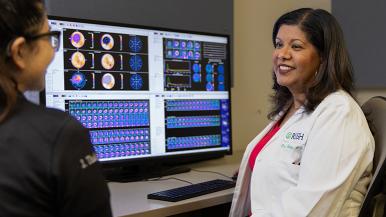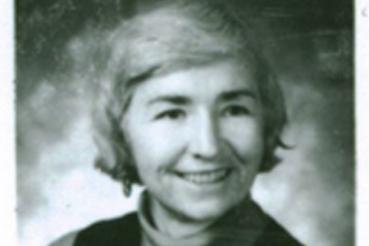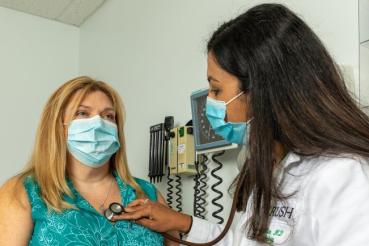While men and women’s hearts may beat as one, and they may bleed or even break, they are not the same.
Heart disease is the No. 1 cause of death in the U.S. for both men and women, but from pregnancy risks to how their arteries function women face different challenges in the prevention, diagnosis and treatment of cardiovascular conditions.
In the 20 years since the RUSH Heart Center for Women opened and the national “Go Red for Women” heart health awareness campaign began, much more is known about heart disease in women. That’s because of research and focused attention on the issue, said Rupa Sanghani, MD, director of the Heart Center for Women.
“Our understanding of how women’s heart disease develops — the physiology, symptoms and risk factors — has advanced greatly in the last 20 years,” she said. “What we’ve learned about diagnosis and treatment, how the disease manifests itself, has led to not only better awareness but improved how we care for patients.” It also has proven the need for more research and clinical trials that involve women.
Women’s common heart symptoms, uncommon risks
A key message to women over the past several years has been that a woman’s heart attack symptoms may be more subtle than a man’s. While chest pain is the most common symptom of heart attack for men and women, only about half of women experience it, and those who do may have a milder feeling than the intense pain described by men.
Women’s symptoms may include the following:
- Chest pain
- Neck pain
- Shortness of breath
- Lightheadedness
- Fainting
- Indigestion
- Nausea
- Vomiting
- Fatigue
“Awareness has increased, but people still don't think of their own risk as being real,” Sanghani said. “They don’t see themselves as being at risk. But all women are at risk over their lifetime, and heart disease affects women in every single age group.”
When a patient has chest pain, the coronary arteries are screened and may show the blockage that is causing the pain. But women who have chest pain often do not show blockage in the coronary arteries, so the cause of their pain may not be understood or properly treated.
Detecting problems in tiny vessels
Coronary artery disease, where there is blockage in the big three arteries, is the most common heart disease in men and women, but women also experience blockages in their microvascular system — the smaller vessels of the heart.
Understanding the role of the small vessels is one of the most important advances related to women’s heart health, Sanghani said.
“A woman may come in with chest pain, or even have enzymes in her blood (troponin) that indicate she’s had a heart attack, but her large heart arteries look normal,” she said. “In the past, her heart condition may have been missed. Now we know that there may be abnormalities in the small vessels.”
Those vessels are small but significant: They account for two-thirds of the heart’s circulation system. But they are hard to see without advanced technology.
RUSH started a cardiac PET scanning program in 2019, the first in Illinois, to better diagnose heart disease, specifically with more focus on blood flow down to the small vessels. Positron-emission tomography can detect problems in ways that other imaging cannot.
“We can look at blood flow at the tissue level,” Sanghani said. “We also started a microvascular program that uses new technology to check how the heart vessels respond to stress, to view how they constrict and dilate.”
Updated risk factors for women
In the 20 years since cardiologist Annabelle Volgman, MD, founded the Heart Center for Women at RUSH, new and emerging risk factors have been recognized or better understood. In addition to the traditional risk factors of diabetes, high blood pressure, smoking, inactivity, obesity and family history, risk factors include inflammatory diseases such as lupus and rheumatoid arthritis, and, most importantly, pregnancy.
“Pregnancy is a nine-month stress test,” Sanghani said. “It can foreshadow future heart problems as well as current disease.”
Heart problems, whether diagnosed or not, are a serious risk to the expectant mother during pregnancy, delivery and after. It’s a leading cause of maternal death and illness.
Problems that develop during pregnancy, such as high blood pressure and high sugar levels often lead to chronic high blood pressure and diabetes later on. This puts them at higher risk of heart disease. To reduce that risk, these patients will need aggressive preventive care to control blood pressure and cholesterol, and to address diabetes contributors such as high blood sugar levels and obesity, said Sanghani, whose specialties include cardio-obstetrics.
Knowledge about how men and women’s hearts differ continues to evolve and includes some clear contrasts. For example, the way cholesterol works to block arteries is not the same: When plaque builds up in men’s arteries, it usually develops distinct clumps of plaque, which can be found on a procedure called an angiogram, and then stents can be placed to improve blood flow. In women, plaque more commonly creates a coating on the artery wall rather than a clump, which makes it harder to see, even in the large arteries.
Women’s physiological response to stress can be dangerously different, too, Sanghani said. A woman’s heart can suffer an acute injury from a severe stress event, such as news of a death in the family.
“The adrenaline surge from that stress causes the heart’s main chamber to fail, affecting its ability to pump,” she said. “It is a biochemical response to stress.”
The condition, which is called broken heart syndrome, Takotsubo cardiomyopathy or stress cardiomyopathy, can be treated and usually improves with supportive care.
Advocate for your health
Sanghani advises women who have heart disease, symptoms or concerns to turn to a cardiologist who is experienced in women’s heart health. From prevention to diagnosis and treatment, women and men need care that addresses their heart.
Patients should not be afraid to speak up and ask questions.
“If you have chest pain or feel ill and think it’s your heart, don’t be sent home without an answer,” Sanghani said.




